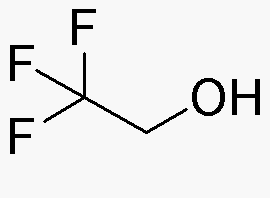Trifluoroethanol is widely utilized in research focused on:
- Solvent in Organic Synthesis: It serves as an excellent solvent for various organic reactions, particularly in the synthesis of fluorinated compounds, enhancing reaction rates and yields.
- Protein Stabilization: In biochemistry, it is used to stabilize proteins and enzymes during experiments, allowing for better structural analysis and functional studies.
- Polymer Production: The chemical is employed in the production of fluorinated polymers, which are known for their chemical resistance and thermal stability, making them ideal for high-performance applications.
- Pharmaceutical Formulations: Trifluoroethanol is used in drug formulation processes, particularly for enhancing the solubility of certain active pharmaceutical ingredients, improving bioavailability.
- Analytical Chemistry: It acts as a solvent in various analytical techniques, such as NMR spectroscopy, providing clearer spectra and better resolution for complex mixtures.
General Information
Properties
Safety and Regulations
Applications
Trifluoroethanol is widely utilized in research focused on:
- Solvent in Organic Synthesis: It serves as an excellent solvent for various organic reactions, particularly in the synthesis of fluorinated compounds, enhancing reaction rates and yields.
- Protein Stabilization: In biochemistry, it is used to stabilize proteins and enzymes during experiments, allowing for better structural analysis and functional studies.
- Polymer Production: The chemical is employed in the production of fluorinated polymers, which are known for their chemical resistance and thermal stability, making them ideal for high-performance applications.
- Pharmaceutical Formulations: Trifluoroethanol is used in drug formulation processes, particularly for enhancing the solubility of certain active pharmaceutical ingredients, improving bioavailability.
- Analytical Chemistry: It acts as a solvent in various analytical techniques, such as NMR spectroscopy, providing clearer spectra and better resolution for complex mixtures.
Documents
Safety Data Sheets (SDS)
The SDS provides comprehensive safety information on handling, storage, and disposal of the product.
Product Specification (PS)
The PS provides a comprehensive breakdown of the product’s properties, including chemical composition, physical state, purity, and storage requirements. It also details acceptable quality ranges and the product's intended applications.
Certificates of Analysis (COA)
Search for Certificates of Analysis (COA) by entering the products Lot Number. Lot and Batch Numbers can be found on a product’s label following the words ‘Lot’ or ‘Batch’.
*Catalog Number
*Lot Number
Certificates Of Origin (COO)
This COO confirms the country where the product was manufactured, and also details the materials and components used in it and whether it is derived from natural, synthetic, or other specific sources. This certificate may be required for customs, trade, and regulatory compliance.
*Catalog Number
*Lot Number
Safety Data Sheets (SDS)
The SDS provides comprehensive safety information on handling, storage, and disposal of the product.
DownloadProduct Specification (PS)
The PS provides a comprehensive breakdown of the product’s properties, including chemical composition, physical state, purity, and storage requirements. It also details acceptable quality ranges and the product's intended applications.
DownloadCertificates of Analysis (COA)
Search for Certificates of Analysis (COA) by entering the products Lot Number. Lot and Batch Numbers can be found on a product’s label following the words ‘Lot’ or ‘Batch’.
*Catalog Number
*Lot Number
Certificates Of Origin (COO)
This COO confirms the country where the product was manufactured, and also details the materials and components used in it and whether it is derived from natural, synthetic, or other specific sources. This certificate may be required for customs, trade, and regulatory compliance.


